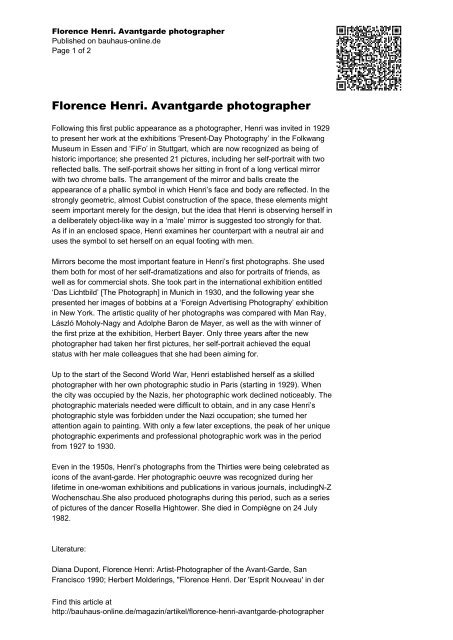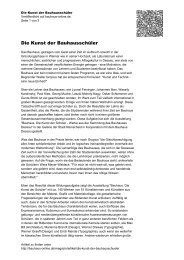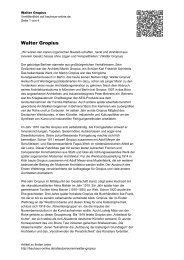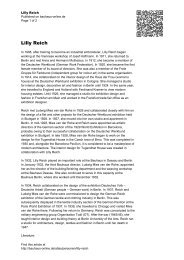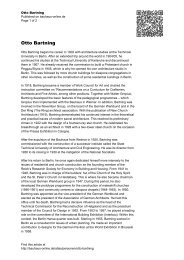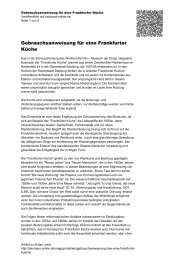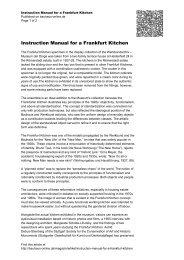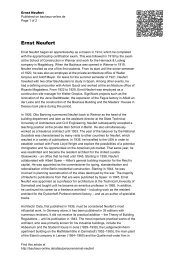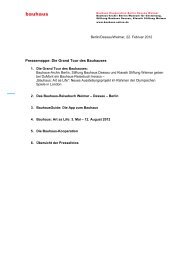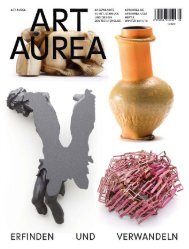Florence Henri. Avantgarde photographer - Bauhaus Online
Florence Henri. Avantgarde photographer - Bauhaus Online
Florence Henri. Avantgarde photographer - Bauhaus Online
Create successful ePaper yourself
Turn your PDF publications into a flip-book with our unique Google optimized e-Paper software.
<strong>Florence</strong> <strong>Henri</strong>. <strong>Avantgarde</strong> <strong>photographer</strong><br />
Published on bauhaus-online.de<br />
Page 1 of 2<br />
<strong>Florence</strong> <strong>Henri</strong>. <strong>Avantgarde</strong> <strong>photographer</strong><br />
Following this first public appearance as a <strong>photographer</strong>, <strong>Henri</strong> was invited in 1929<br />
to present her work at the exhibitions ‘Present-Day Photography’ in the Folkwang<br />
Museum in Essen and ‘FiFo’ in Stuttgart, which are now recognized as being of<br />
historic importance; she presented 21 pictures, including her self-portrait with two<br />
reflected balls. The self-portrait shows her sitting in front of a long vertical mirror<br />
with two chrome balls. The arrangement of the mirror and balls create the<br />
appearance of a phallic symbol in which <strong>Henri</strong>’s face and body are reflected. In the<br />
strongly geometric, almost Cubist construction of the space, these elements might<br />
seem important merely for the design, but the idea that <strong>Henri</strong> is observing herself in<br />
a deliberately object-like way in a ‘male’ mirror is suggested too strongly for that.<br />
As if in an enclosed space, <strong>Henri</strong> examines her counterpart with a neutral air and<br />
uses the symbol to set herself on an equal footing with men.<br />
Mirrors become the most important feature in <strong>Henri</strong>’s first photographs. She used<br />
them both for most of her self-dramatizations and also for portraits of friends, as<br />
well as for commercial shots. She took part in the international exhibition entitled<br />
‘Das Lichtbild’ [The Photograph] in Munich in 1930, and the following year she<br />
presented her images of bobbins at a ‘Foreign Advertising Photography’ exhibition<br />
in New York. The artistic quality of her photographs was compared with Man Ray,<br />
László Moholy-Nagy and Adolphe Baron de Mayer, as well as the with winner of<br />
the first prize at the exhibition, Herbert Bayer. Only three years after the new<br />
<strong>photographer</strong> had taken her first pictures, her self-portrait achieved the equal<br />
status with her male colleagues that she had been aiming for.<br />
Up to the start of the Second World War, <strong>Henri</strong> established herself as a skilled<br />
<strong>photographer</strong> with her own photographic studio in Paris (starting in 1929). When<br />
the city was occupied by the Nazis, her photographic work declined noticeably. The<br />
photographic materials needed were difficult to obtain, and in any case <strong>Henri</strong>’s<br />
photographic style was forbidden under the Nazi occupation; she turned her<br />
attention again to painting. With only a few later exceptions, the peak of her unique<br />
photographic experiments and professional photographic work was in the period<br />
from 1927 to 1930.<br />
Even in the 1950s, <strong>Henri</strong>’s photographs from the Thirties were being celebrated as<br />
icons of the avant-garde. Her photographic oeuvre was recognized during her<br />
lifetime in one-woman exhibitions and publications in various journals, includingN-Z<br />
Wochenschau.She also produced photographs during this period, such as a series<br />
of pictures of the dancer Rosella Hightower. She died in Compiègne on 24 July<br />
1982.<br />
Literature:<br />
Diana Dupont, <strong>Florence</strong> <strong>Henri</strong>: Artist-Photographer of the Avant-Garde, San<br />
Francisco 1990; Herbert Molderings, "<strong>Florence</strong> <strong>Henri</strong>. Der 'Esprit Nouveau' in der<br />
Find this article at<br />
http://bauhaus-online.de/magazin/artikel/florence-henri-avantgarde-<strong>photographer</strong>
Powered by TCPDF (www.tcpdf.org)<br />
<strong>Florence</strong> <strong>Henri</strong>. <strong>Avantgarde</strong> <strong>photographer</strong><br />
Published on bauhaus-online.de<br />
Page 2 of 2<br />
Fotografie", in: Herbert Molderings, Die Moderne der Fotografie, Hamburg 2008, S.<br />
353-363; László Moholy-Nagy, "zu den fotografien von florence henri", i10<br />
internationale revue, No. 17-18, 1928 (XII), S. 117; Kunstsammlung<br />
Nordrhein-Westfalen, Düsseldorf (Hg.), Die andere Seite des Mondes.<br />
Künstlerinnen der <strong>Avantgarde</strong>, Köln 2011; Hôtel des Arts / Giovanni Battista Martini<br />
(Hg.), <strong>Florence</strong> <strong>Henri</strong>. Parcours dans la Modernité – Peinture / Photographie 1918 ><br />
1979, Toulon 2010; letter by <strong>Florence</strong> <strong>Henri</strong> to Lou Scheper-Berkenkamp,<br />
11.2.1928, Paris, Nachlass Scheper, Berlin<br />
Published on 12/12/2012<br />
Find this article at<br />
http://bauhaus-online.de/magazin/artikel/florence-henri-avantgarde-<strong>photographer</strong>


